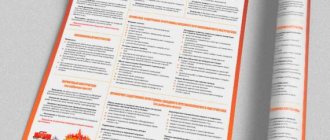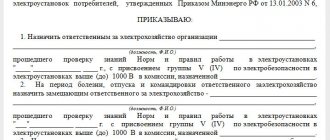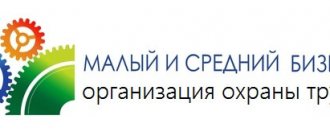Basic provisions
The manager or owner of the organization is responsible for organizing fire safety training: it is this person who must provide his employees with knowledge in the field of fire safety. Instruction can be carried out personally by the manager or by responsible persons trained and appointed by order of the manager. Instruction is carried out in accordance with the procedure approved by law, taking into account the specifics of the organization. Fire safety standards were approved in detail in the Order of the Ministry of Emergency Situations No. 645 dated December 12, 2007 (as amended on June 22, 2010).
It must be borne in mind that employees responsible for fire safety of organizations and conducting fire safety briefings are required to undergo fire safety .
What is included in fire safety training:
— Familiarization of workers with basic fire safety requirements;
— Study by workers of the fire hazard of technological processes used in production;
— Training of workers in the rules of using fire protection equipment;
— Training of workers on actions to be taken in the event of a fire.
In addition, as part of fire safety training, employees must be familiarized with the rules for proper maintenance of the territory, buildings and premises of the organization, with evacuation routes and the process of evacuating people, with the rules for using open fire during work, as well as with the rules for calling the fire brigade and how to Fire extinguishing agents and fire automatics should be used.
It is important that the training takes into account the specifics of the organization and that the knowledge gained is regularly tested. Particular attention should be paid to the practical component of training. This is what gives employees the opportunity to behave competently in an emergency situation and quickly take the necessary actions.
Fire technical minimum
The timing and procedure for passing the Fire Technical Minimum (FTM) is regulated by Order 645 of the Ministry of Emergency Situations of the Russian Federation. Who needs to obtain a fire safety certificate is determined by the head of the enterprise by issuing an order.
How this document is drawn up can be clarified on this page.
Training is carried out in specialized training centers or on the basis of the Ministry of Emergency Situations. It can be either full-time or remote (remote).
The PTM certificate must be obtained:
- Persons acting as heads of government;
- Persons acting as local government bodies;
- Heads of enterprises, their deputies (regardless of the legal form - individual entrepreneur, LLC, CJSC, etc.), as well as chairmen of dacha and gardening partnerships;
- All engineers (power engineer, chief mechanic, technologist, etc.);
- Persons appointed to the role of fire safety officer;
- Persons appointed to provide instructions;
- Workers performing work at facilities where hot work is carried out, as well as where highly flammable and combustible materials are stored.
Specialists performing hot work (welders, roofers, etc.) are issued a PTM coupon - a permit for hot work in the form of an insert (attachment to the main certificate).
Summary.
All employees of any organization must undergo fire safety training. The type of training depends on the position held and the work performed.
The manager of the enterprise should be primarily interested in ensuring that specialists receive comprehensive training. Workers must know exactly WHAT needs to be done in case of fire, escape routes, use of fire extinguishing agents, etc.
Yes, mostly training is carried out formally: employees sign in the log and okay, the inspector won’t bother. But the knowledge that an employee receives during instruction can save someone’s life, and this is much more expensive than any fine.
Types of fire safety briefings
Fire safety regulations divide fire safety instructions into several types:
- introductory
- primary at the workplace
- repeated
- unscheduled
- target
Please note that in order to record the conduct of briefings, the company is required to keep logs of the conduct of safety briefings . According to paragraphs 9 and 10 of the Safety Regulations, appropriate entries are made there, confirmed by the signatures of the person being instructed and the person instructing. Our specialists can help with the preparation of labor protection documentation.
Induction training must be carried out with all employees hired without exception, regardless of their education and work experience. Induction training is also carried out with employees seconded to the organization, with persons arriving for practical training or training, and with other persons at the discretion of the employer.
The introductory briefing is conducted by the manager or employee appointed responsible for industrial safety. The legislation establishes a rule according to which introductory instruction must be carried out in an equipped room according to a program approved by order, and the instruction must be accompanied by practical training.
Initial on-the-job training is also carried out for all newly hired employees; with those who were transferred from one division of the company to another; with those performing new work for them; with seasonal workers; as well as with construction specialists performing construction, installation or other work on the company’s territory.
Such instruction is carried out by persons responsible for industrial safety in structural units, again according to approved programs. Initial training is carried out individually with each employee, but can also be carried out with groups of people if they work on the same type of equipment.
Repeated briefing is carried out for all employees of the organization by the same person as the introductory one. Such instruction is necessary to test and update knowledge of fire safety rules, regulations, standards and instructions.
Unscheduled briefing is carried out if:
— New rules, regulations and instructions on industrial safety have been introduced or any changes have been made to them;
— The factors influencing the fire safety condition of the facility have changed. For example, the production process was changed or equipment was modernized;
— Employees violated safety rules, which led to a fire;
— Accidents/fires occurred at similar industries.
Unscheduled training is also carried out for employees who have had a long break from work (more than 30 calendar days for regular work and more than 6 days for work with additional requirements).
Unscheduled briefing is carried out by a person appointed by order of the manager to be responsible for industrial safety in the organization.
Targeted instruction is necessary when:
— one-time work with increased fire hazard;
— liquidation of consequences of accidents;
— carrying out work with the issuance of a work permit, hot work in explosive industries;
— conducting excursions, organizing public events with students and other persons (meetings, meetings with a number of participants of 50 or more people).
General facility instructions on fire safety measures
In accordance with regulatory standards, this development is intended to formulate general industrial safety requirements at all facilities that are part of the institution. The instructions are mandatory for all employees and officials of the company, including managers. Violation of its requirements entails liability provided for by the laws of the Russian Federation.
The main objectives of this regulation include creating a safe environment for people working on site. First of all, this applies to cases of fire directly in a building or structure. Employees performing their duties are not allowed to enter the workplace without being instructed and familiarized with the requirements of this form.
When preparing the regulations, the level of responsibility for each employee and official is determined by the owner or director of the institution. He appoints those responsible for the fire safety condition of technological equipment, production lines, premises, and electrical networks. Overall responsibility for teaching staff lies with the heads of the organization and structural divisions.
When preparing the rules, one of the paragraphs should indicate the order and frequency of conducting instructional classes. It also defines the actions of employees in the event of a fire and the procedure for carrying out work related to the use of fire.
Timing of briefings
Education in the field of occupational safety must be systematic and regular. For this purpose, the standards establish the frequency of fire safety briefings.
Repeated fire safety briefings should be carried out once a year for ordinary organizations and 2 times a year for enterprises that are classified as facilities with a fire-hazardous technological process/production.
For other types of briefings, frequency should be based on practical considerations and common sense. For example, it is obvious that induction training is carried out before a new employee starts working, and unscheduled training is carried out when the above-mentioned cases occur.
Accounting for fire safety training
To record the conduct of fire safety briefings, the organization must maintain a Fire Safety Briefing Log. The appropriate entries are made in the journal with the obligatory indication of the signatures of the person being instructed and the person instructing, as well as the date of the instruction.
The form of such a Journal is approved by Order of the Ministry of Emergency Situations of the Russian Federation dated December 12, 2007 N 645 “On approval of fire safety standards “Training in fire safety measures for employees of organizations”:
This journal is prepared for all types of briefings.
A log of fire safety briefings is necessary to monitor work in compliance with the established deadlines for conducting briefings.
The journal must be numbered, laced, signed by the person responsible for its maintenance, and sealed with the seal of the organization.
A log of fire safety briefings must be kept by the person responsible for fire safety.
When checking by fire safety inspectors, close attention will be paid to whether your organization conducts fire safety training or not. The presence of a correctly completed Fire Safety Instruction Log will serve as the main evidence base for the conduct of this event.
Responsibility for lack of training
Violation of fire safety rules, according to Article 20.4 of the Code of Administrative Offenses of the Russian Federation, entails a warning or the imposition of an administrative fine of 2,000 rubles for citizens and up to 200,000 rubles for legal entities.
If the violations result in a fire, then the penalties increase: for minor damage, the amounts of fines vary from 4,000 rubles for citizens to 400,000 rubles for legal entities. The more serious the consequences of such a violation, the higher the punitive measures: if the fire caused serious harm to health or resulted in the death of a person, then sanctions on legal entities can reach 1,000,000 rubles . Also, a violation in this case may entail administrative suspension of the company’s activities for up to 90 days.
Failure to conduct briefings and/or lack of a logbook to record their implementation, although not a gross violation, does entail additional thorough checks by government agencies, which often leads to the identification of additional violations, and therefore to large fines.
Not sure that your company has everything in order with occupational health and safety at work and in offices? Sign up for a consultation with our specialists: 7 (495) 252-10-09. We will provide an occupational safety audit, advise on instructions and help bring the documentation to the required form.
Program structure
A list of questions and sample training plans are given in Order No. 645. When an enterprise draws up its own program for conducting fire safety training in the workplace, this normative act must be taken as a basis. Briefly, it includes the following topics:
- evacuation plan;
- emergency exits;
- location of fire extinguishers and fire protection equipment;
- information about the technology of using fire extinguishers and their types;
- possible causes of fire in the workplace and the enterprise as a whole;
- hazardous properties of materials and raw materials used by the company;
- information about the employee’s personal safety in case of fire;
- methods of providing medical care (before the arrival of specialists);
- other topics that need to be covered depending on the specifics of work activity.
A plan for conducting fire safety training must be developed in advance, signed by the developer, and agreed upon with a representative of the fire service.
Next to each topic you must indicate the number of hours.
Unscheduled briefing
Unscheduled fire safety training is carried out:
— when introducing new or changing previously developed rules, regulations, fire safety instructions, and other documents containing fire safety requirements;
— when replacing or upgrading equipment, tools, as well as changing other factors affecting the fire safety condition of an enterprise (organization, institution);
- in case of violation by employees of an enterprise (organization, institution) of fire safety requirements, which could lead or did lead to a fire;
— for additional study of fire safety measures at the request of state fire supervision authorities when they identify insufficient knowledge among employees of an enterprise (organization, institution);
— during breaks in work for more than 60 calendar days;
— upon receipt of information materials about accidents, fires that occurred at enterprises (organizations, institutions);
- when establishing facts of unsatisfactory knowledge by employees of an enterprise (organization, institution) of fire safety requirements.
Unscheduled fire safety training is carried out by those responsible for ensuring fire safety at an enterprise (organization, institution), individually or with a group of workers of the same profession. The volume and content of unscheduled fire safety briefings are determined in each specific case, depending on the reasons and circumstances that necessitated the need for it.
Who is responsible for developing the program?
The head of the organization is responsible for conducting fire training and developing the program. But he can assign these responsibilities to another employee. Compliance with fire safety rules and regulations is the key to safe work of personnel, safety of enterprise property, and the avoidance of fines from regulatory authorities.
Legal documents
- Federal Law No. 69-FZ of December 21, 1994
- Order of the Ministry of Emergency Situations of the Russian Federation dated December 12, 2007 No. 645
- Decree of the Government of the Russian Federation of April 25, 2012 No. 390
- Order of the Ministry of Emergency Situations of Russia dated December 12, 2007 No. 645
Re-briefing
Repeated fire safety briefing is carried out by the person responsible for fire safety, appointed by order of the head of the enterprise (organization, institution) with all employees, regardless of qualifications, education, experience, nature of the work performed, at least once a year.
Repeated fire safety training is carried out in accordance with the training schedule approved by the head of the enterprise (organization, institution).
Repeated fire safety briefing is carried out individually or with a group of workers servicing the same type of equipment within a common workplace according to the program of primary fire safety briefing at the workplace.
During the repeated fire safety briefing, knowledge of fire safety standards, rules, norms and instructions, the ability to use primary fire extinguishing equipment, knowledge of evacuation routes, fire warning systems and management of the evacuation process are tested.
Regulatory documentation
The main document regulating the conduct of such events in any production is the Federal Law on Fire Prevention and Fire Regime in the Russian Federation. In addition, there is a special instruction No. 645 PB from the Ministry of Emergency Situations, which regulates them in various industries. Also, certain instructions are created in line ministries and departments, the conditions of which provide for the specifics of activities in the organization.
At enterprises, regulation of this activity is carried out through the publication of local regulations, which must be drawn up in strict accordance with higher federal standards. Verification of compliance of these acts is carried out as a result of state inspections. Such documents directly in the organization take the form of instructions, regulations, and the organization is carried out as a result of the issuance of an order or regulation.
Learning illustration










